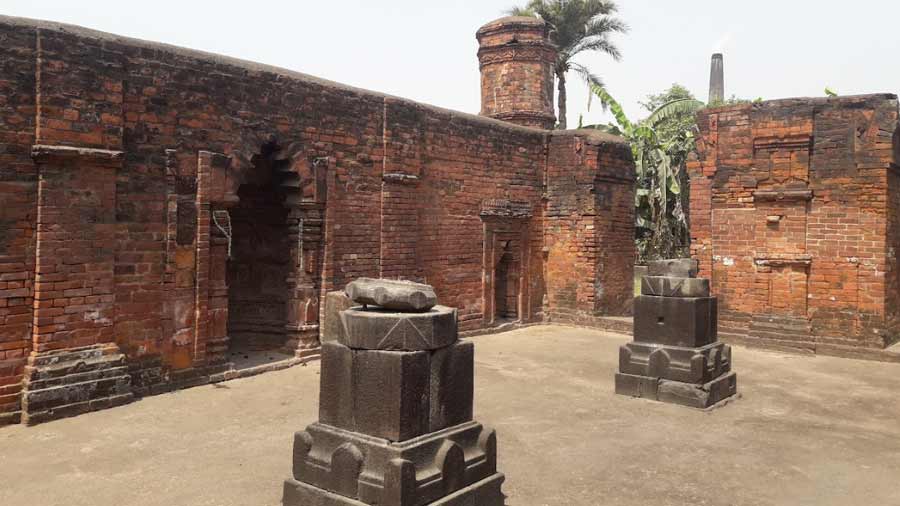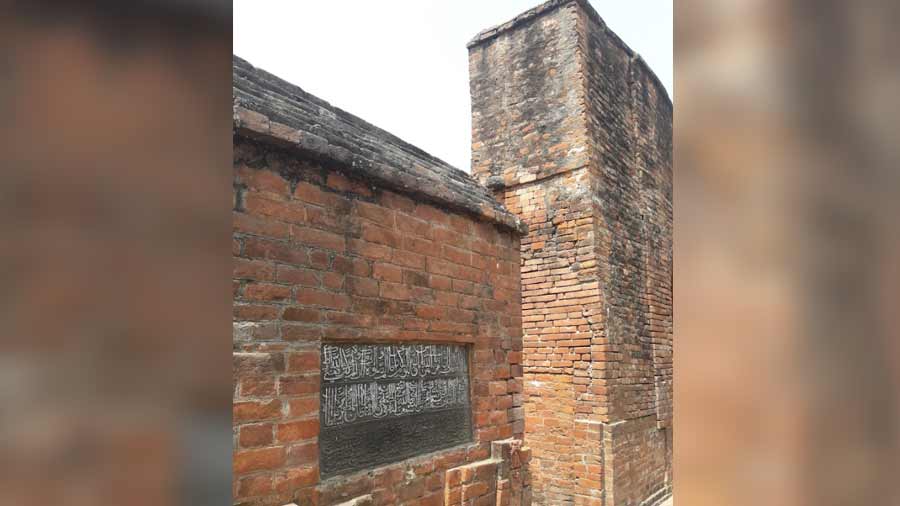The Mauryan-era port of Tamralipta or Tamralipti, which is modern-day Tamluk in East Midnapore (Purba Medinipur) saw a decline in the ninth century AD. This led to the formation of a new port at the confluence of the rivers Ganga and Saraswati — a small port town by the name of Saatgaon or Saptagram.
Today’s semi-urbanised Saptagram, often referred to as Adisaptagram, bears no evidence of this glorious past. The only tangible connection is the edifice of the Sayed Jamaluddin mosque.
The heyday of a historic port town

The Saraswati river as seen today at Adisaptagram Wikimedia Commons
The river port, whose name meant “an assembly of seven villages,” dominated eastern Indian trade and commerce until the end of the 16th century. European ships brought goods from Italy and Portugal and Bengal’s famous silks were shipped out from Saptagram.
Ibn Battuta, who is said to have visited the port in 1345 during the rule of Nawab Faqiruddin, has reportedly mentioned the port as one where slave trade was a regular occurence as well, along with the trading of sugar, cotton, silk and cows.
Some scholars believe that Egyptian geographer Ptloemy, who visited India in the second century AD, was talking of today’s Tribeni in Bansberia, Hooghly, when he mapped a port near Bay of Bengal called Tilograman. It is near Tribeni that Saptagram’s port town flourished.
With the emergence of Hooghly and Calcutta in the 17th century, Saptagram gradually dissolved into oblivion; alive only in Bengali novels and folklore, and family stories.
Connection to past glories

There are different accounts for the origin of Saptagram masjid, but it dates back to the 16th century or earlier Courtesy: Somen Sengupta
The ruins of the Saptagram masjid are believed to date back to the 16th century or earlier. In 1298, the flourishing trade port was conquered by Jafar Khan Gazi, defeating a Hindu king. Over the next few decades, waves of invasion completely changed the political and social character of the area.
Two prominent mosques were built in the decades following Ghazi’s conquest — one in Saptagram and the other in Tribeni. Historians believe there is a gap of more than 200 years between the establishment of these two mosques. The one at Saptagram, reportedly built by the son of Nawab Faqiruddin, is small, simple and largely dilapidated. It is under the jurisdiction of the Archaeological Society of India (ASI), and there’s just enough information to glean an account of its history.
Digging into origin stories

A stone tablet found in the mosque documents its history Courtesy: Somen Sengupta
There are different accounts of the origins and the year of foundation of this historic building. The ASI sign board mentions 1529 as the year of foundation by Sayed Jamaluddin, son of Nawab Faqiruddin. However some scholars opine that it was founded in 1457, or 892 Hijri, by one Tarbiyat Khan.
Both accounts refer to different dedicatory tablets with Arabic inscriptions, which were found inside of the mosque’s premises. One, placed in the central wall of the edifice, is more prominent and the source referred to by the ASI.
However, in his book Hoogly Jelar Deb-Deul, Sudhir Kumar Mitra, known for his work on Hooghly’s archaeological heritage mentions 1457 as the year of foundation. While he does not state a source for his information, it could have been taken from another partially broken stone inscription from the mosque.
Stories in brick and stone

The graves of Sayed Faqruddin, his wife and his servant Courtesy: Anamika Sengupta
Within the unassuming brick walls are three bays that can be accessed from three entry gates on the eastern side of the structure. Only one of the four minarets still stands intact, and inside, broken stone pillars indicate that the building had a mix of brick and stone architecture, and a roof that has long caved in.
Along the western wall, one of the three prayer chambers have terracotta motifs on the wall, probably an influence from the local handicrafts of the region. Most of the terracotta panels have decayed with time, the few still found along the walls show traditional floral motifs. The only remaining structures from the roof of the mosque are two broken domes on both sides. One arched gate with a high wall, gives an indication of the size of the mosque.
Outside the mosque but within the premises of the building is a compound that has the tombs of Sayed Faqruddin, his wife and a servant, who some believe was the Nawab’s Khoja slave. Two stone tablets in front of these graves warn people from destroying the sanctity of a mosque or forcefully grabbing the land it stands on, as those are the estates of the almighty.
Sentinel of lost history

A treasure trove of artifacts has been excavated in Saptagram Courtesy: Anamika Sengupta
Over the centuries since the glory and decline of Saptagram, several people have systematically or accidentally found many treasures here. Rakhaldas Banerji, the legendary archaeologist, had unearthed a broken Saraswati image of historical significance here. In 1963, during the construction of the Bandel thermal power station, a Surya idol was found in the area and four years before that, the Bengal government had excavated a treasure trove of artifacts from the region.
This unassuming Sayed Jamaluddin mosque still stands today, with its many tales, stories and disputes as the last sentinel of a glorious past.
